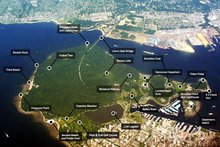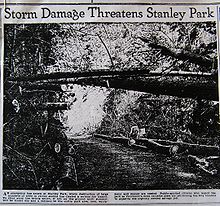Stanley Park
The Stanley Park is a 404.9 hectare large park in Vancouver . It is the largest urban park in Canada and the third largest in North America. The park, named after Frederick Arthur Stanley , is located right next to the city center on the northern tip of a peninsula that protrudes into the Burrard Inlet fjord . It is visited by around eight million locals and tourists every year. A 200 km long network of walking paths runs through the park. Most of the park consists of a forest with around half a million trees. Sights include Beaver Lake, the Vancouver Aquarium , the offshore island of Deadman's Island, Siwash Rock and the 8.8 km long seawall that surrounds the entire park with a lane for walkers, cyclists and rollerblades.
history
Archaeological research shows that the park was inhabited at least 3000 years ago. The region was one of the most densely populated in North America at the end of the 18th century and is unique in that this high population was not based on agriculture but on fish and other marine life. An extensive network of relatives also made it possible for other groups, mostly house groups, who themselves did not live in the park area, to gain access to certain resources. Therefore, the park is considered a common property for the surrounding First Nations . Investigations at the end of the 20th century registered so-called Culturally Modified Trees just east of Pipeline Road 92 , i.e. trees on which traces of processing can be detected, some of which are several centuries old.
Captain George Vancouver explored the area in mid-June 1792 as the second European after the Spaniard José María Narváez and met the Squamish Indian tribe there . 50 of them greeted him with dignity and very “civilized” (“with the greatest decorum and civility”) in canoes, brought gifts and food, for which they expected the rare and coveted iron. At that time the park was still an island. The Indians tried a musket and looked at the skin of the Europeans with infinite curiosity. Vancouver suspected that the houses were in the woods.
It wasn't until several decades later, during the Crimean War , that the British returned. They formed a defensive alliance with the Squamish; these were to defend the north bank of the Burrard Inlet in the event of an attack , the British the south bank. The expected attack by the Russians did not materialize, however, and in the early 1860s the peninsula was declared a restricted military area. The peninsula would be strategically located if US troops had tried to attack the then provincial capital New Westminster from Burrard Inlet.
Although six forest companies were active in the area between the 1860s and 1880s, the peninsula was spared from large-scale clearing due to military use. In 1886 the city of Vancouver was founded. As a first official act, the city council decided to petition the Canadian Dominion government, requesting that the restricted area be leased and converted into a park.
After the government granted this request, the city council appointed a six-person commission to manage the park. In 1890 it was replaced by the Vancouver Park Board , whose seven members are elected instead of appointed by the city's residents. The commission now manages 192 green spaces across Vancouver for a total of 12.78 km², with Stanley Park being by far the largest.
On September 27, 1888, the official opening of the park, which was named after Frederick Arthur Stanley , the then Canadian Governor General . In 1908 the government extended the lease for another 99 years.
The largest Indian settlement was Xwayxway - now Lumbermen's Arch - the exact extent of which is not clear and where , according to a letter from the anthropologist Charles Hill-Tout , numerous skeletons had been found. But it was leveled when the road was built. The big house was therefore 60 by 20 m; it housed 11 families with a total of 100 people. Another Squamish village in the park was called Chaythoos, plus Slhxi'7elsh (Siwash Rock), Ch'elxwa7elch (Lost Lagoon / Coal Harbor), Oxachu (Beaver Lake) and Papiyek (Brockton Point) and Skwtsa7s (maybe Deadman's Island).
A large potlatch took place in Xwayxway in 1875 , but a little later the city government recommended demolishing the village because of an alleged smallpox epidemic . The houses of the Indians who lived in the park until well into the 1880s were demolished without warning, as August Jack Khatsahlano (1875–1971) reported in 1934. The residents temporarily found a place to stay at Kitsilano Point (named after Xats'alanexw, the Squamish name of chief Khatsahlano), but they were also evicted from there. They took away the remains of Chief Supplejack, August Jack Khatsahlano's father, kept in a canoe-shaped sarcophagus. The inauguration ceremony for the park took place on the area of the demolished village.
On November 11, 1988, Stanley Park was declared a National Historic Site of Canada by the Canadian government . In 1995 archaeological investigations found four previously unknown sites, and new knowledge was gained from five of the seven known sites. The investigation was limited to the eastern part of the park; an overall examination never took place.
Heavy storms have repeatedly been perceived as a threat to the tree population, and the resulting fire hazard has also been discussed in local newspapers. Fires keep breaking out to this day, most recently in 2007 and in April 2009. The 11th Annual Bright Nights , which have already been held 11 times, are used to collect money for the protection of the park. 500 firefighters and 85,000 visitors took part in 2007.
Attractions
nature
The forest that covers large parts of the park is not the result of landscape architecture , but has grown naturally. The tree population is mostly secondary forest and consists of tall Douglas firs , gigantic trees , western hemlocks and Sitka spruces . In isolated places, untouched primary forest can also be found. Large areas were deforested in three natural disasters . The first was a severe autumn storm in October 1934, followed by a severe snow storm in January and February 1935 that killed thousands of trees. Another storm in October 1962, an extension of Typhoon "Freda" over the Pacific , destroyed an approximately 2.5 km² forest area. On December 15, 2006, a violent winter storm (wind speeds of up to 215 km / h) caused major damage to 40% of the forest area. Since 1992 the tallest trees have been cut back by the park employees for safety reasons.
The Siwash Rock is a monolith-like rock that lies about ten meters off the northwest coast of the peninsula. It rises 18 meters, is of volcanic origin and was formed around 32 million years ago by erosion . Beaver Lake is a lake in the center of Stanley Park that is surrounded by forest on all sides and attracts many species of water birds. The many water lilies remove oxygen from the lake, which is therefore less and less able to break down organic material and slowly turns into a swamp. The Lost Lagoon is located at the southern end of the park and is an artificially created lake. It was created in 1916 when a sea bay was divided in two by the construction of a road embankment.
Deadman's Island is located southwest of the park in Coal Harbor . This 3.8 hectare island got this name because there is an Indian burial place on it. Until 1887, the island was also used as a cemetery by European settlers.
recreation
There are numerous recreational and leisure facilities in the park. The most popular is the seawall , which runs around the entire peninsula along the coast and in places was carved into the steeply sloping rocks. Construction of this 8.8 km long sea wall began in 1914, but was not declared finished until September 26, 1971. On the Seawall there is a paved path for walkers, joggers, cyclists and inline skaters. The last two groups mentioned are only allowed to use the path counterclockwise. For pedestrians and joggers, the path has been extended to a length of 22 km at both ends. It starts at Canada Place , runs around the park, along the beach at English Bay and then around False Creek and ends at Kitsilano Beach. The seawall is also followed by a short section of the 18,078 kilometer Trans Canada Trail .
A miniature park railroad runs on a circuit between the east coast of the peninsula and Beaver Lake. The length is two kilometers, the track width 508 mm. A replica of the train that first reached Vancouver on the transcontinental railroad in 1887 is used. There are also numerous tennis courts, an 18-hole mini golf course and two swimming pools. Theatrical performances have been held at the Marion Malkin Memorial Bowl since 1934 .
Wildlife

Until 1996, the park's main attraction was a zoo , the origins of which go back to the first park director, Henry Avison, who captured and chained a black bear . The zoo, which grew out of Avison's collection of animals, featured over 50 different species of animals, including snakes , wolves , emus , bison , kangaroos , monkeys, and Humboldt penguins . When the zoo was to be upgraded in 1994, the residents of Vancouver decided instead in a referendum to gradually close it. Stanley Park Zoo closed for good in December 1997 after the last animal, a polar bear named Tuk, died at the age of 36.
The Vancouver Aquarium opened in 1956 and is Canada's first and largest aquarium. You can visit dolphins , beluga whales , Steller sea lions , seals and sea otters . A total of 300 species of fish, thousands of invertebrates, 56 species of amphibians, 60 mammals and birds live there. In November 2006, the park authorities approved an expansion, despite opposition from animal rights activists.
Wildlife species include raccoons , coyotes , rabbits and gray squirrels . The latter are descended from eight animals that were donated from Central Park in New York in 1909 .
Monuments
Numerous monuments have been erected in Stanley Park over the years. These include statues of Lord Stanley, Robert Burns , Harry Jerome and Warren G. Harding , a plaque for the steamship SS Beaver, which sank in 1892, the grave of Pauline Johnson, and a number of totem poles . The park administration has prohibited the erection of further monuments in order to preserve the natural state of the park.
literature
- Sean Kheraj: Inventing Stanley Park: An Environmental History . University of British Columbia Press 2013, ISBN 978-0774824255 , (Book publisher website: Inventing Stanley Park )
Web links
- Stanley Park ( English, French ) In: The Canadian Encyclopedia .
- City of Vancouver: Stanley Park (official website, English)
- Stanley Park Ecology Society
Individual evidence
- ^ Jean Barman: Stanley Park's Secret: The Forgotten Families of Whoi Whoi, Kanaka Ranch, and Brockton Point , Harbor Publishing 2005.
- ↑ Before Stanley Park: First nations sites lie scattered throughout the area , in: Vancouver Sun, March 17, 2007 ( Memento of the original from November 8, 2012 in the Internet Archive ) Info: The archive link was automatically inserted and not yet checked. Please check the original and archive link according to the instructions and then remove this notice. .
- ^ Stanley Park National Historic Site of Canada. In: Canadian Register of Historic Places. Retrieved October 17, 2013 .
- ↑ 11th Annual Bright Nights in Stanley Park Raises $ 126,000 ( Memento of the original from May 14, 2009 in the Internet Archive ) Info: The archive link was automatically inserted and not yet checked. Please check the original and archive link according to the instructions and then remove this notice.
Coordinates: 49 ° 18 '10 " N , 123 ° 8' 40" W.







